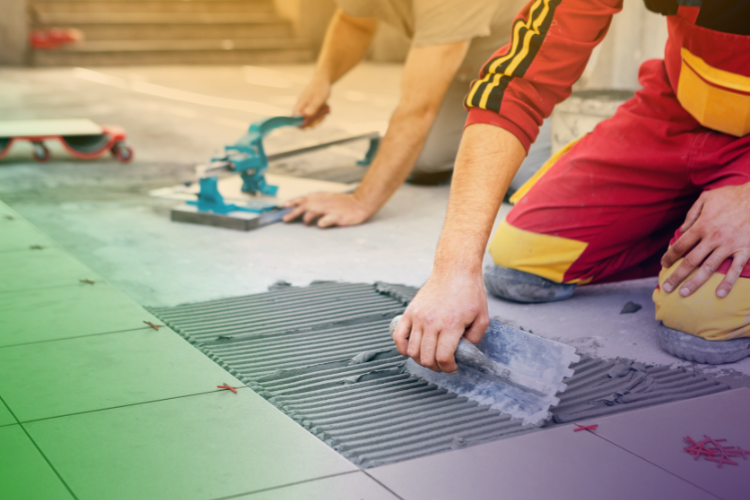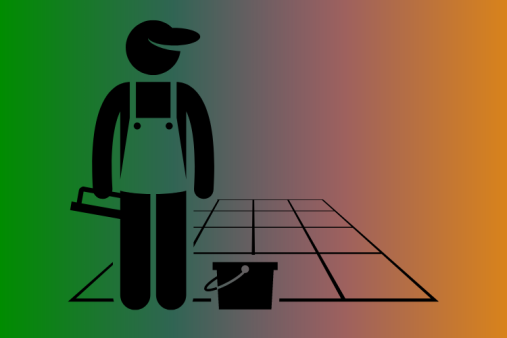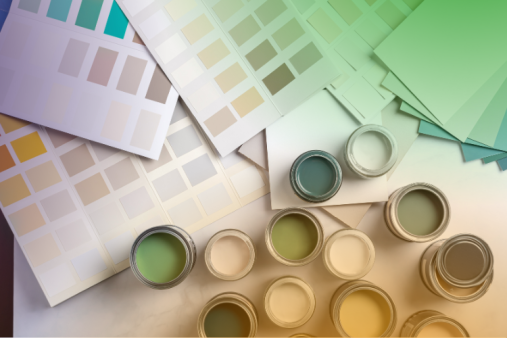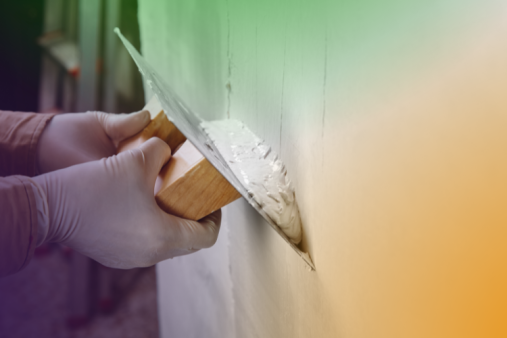When embarking on a tiling project, whether it's sprucing up a kitchen splashback or laying a new bathroom floor, understanding the terminology can be crucial for success. From adhesives to Zellige, the world of tiling is filled with specific terms and techniques that can be overwhelming for beginners and even some seasoned DIY enthusiasts.
To help you navigate this intricate landscape, we've put together a comprehensive A-Z tiling glossary.. This guide will clarify the key terms and concepts, making your tiling projects smoother and more professional. Dive into our glossary to equip yourself with the knowledge needed to tackle any tiling task with confidence and precision.
A
- Adhesive: A substance used to bond tiles to a surface.
- Aggregate: Materials like sand or gravel added to mortar for added strength.
- Alkaline: A basic substance that can affect the setting of certain adhesives.
- Angle Grinder: A tool used for cutting tiles to shape.
- Anti-Fracture Membrane: A material applied to a surface to prevent cracks from appearing in tiles.
- Apron: The border of tiles that extends out from a tiled area, often decorative.
B
- Back Buttering: Applying adhesive to the back of a tile before placing it.
- Backer Board: A cementitious board used as a base for tiling.
- Bevelled Edge: Tiles with edges that are cut at an angle, usually for a decorative finish.
- Biscuit: The unglazed base of a ceramic tile.
- Border Tile: Decorative tiles used to create a border pattern.
- Box Screed: A tool used to level out mortar before laying tiles.
C
- Caulk: A material used to fill joints and seal seams against leakage.
- Ceramic Tile: A tile made from clay that has been fired in a kiln.
- Chalk Line: A tool used to mark straight lines on a surface for accurate tile placement.
- Chequerboard: A pattern of alternating coloured tiles.
- Cladding: Tiles applied to the exterior surfaces of buildings.
- Corner Trim: A piece used to finish the edges of tiled surfaces.
- Cove Tile: A tile with a curved edge, typically used where walls meet floors.
- Crackle Glaze: A decorative glaze that has a network of fine cracks.
D
- Dado Tile: A decorative tile used for borders or to break up plain tiled surfaces.
- Deco Tile: Tiles with decorative designs, used for adding detail.
- Density: The weight per unit volume of a tile, affecting its durability and strength.
- Diamond Blade: A cutting blade with diamond tips, used for cutting hard tiles.
- Dry Layout: Arranging tiles on the surface without adhesive to plan the placement.
E
- Edge Tile: A tile designed for finishing the edge of a tiled area.
- Efflorescence: A white, powdery residue left on tiles due to soluble salts migrating to the surface.
- Epoxy Grout: A durable and waterproof grout used for areas exposed to water.
F
- Field Tile: The main tile used in a tiling project.
- Flexible Grout: Grout that allows for slight movements in the tiled surface without cracking.
- Float: A tool used to apply grout to tiles.
- Frost-Resistant Tile: Tiles designed to withstand freezing temperatures without damage.
G
- Glazed Tile: Tiles with a glassy coating applied during firing for a glossy finish.
- Grout: A material used to fill the gaps between tiles.
- Grout Sealer: A protective coating applied to grout to prevent staining and moisture penetration.
- Gypsum: A mineral used in some tile backer boards.
H
- Honed Tile: A tile that has been ground to a smooth, matte finish.
- Herringbone: A pattern where tiles are laid in a zigzag design.
I
- Impervious: A tile's ability to resist water absorption.
- Inset: A decorative tile embedded within a field of other tiles.
- Interlocking Tiles: Tiles designed to fit together like puzzle pieces.
J
- Joint: The space between tiles filled with grout.
- Joint Width: The distance between adjacent tiles.
K
- Kick Board: A strip of material at the base of cabinets to protect the wall from kicks.
L
- Lippage: The variation in height between adjacent tiles.
- Listello: A decorative border tile.
- Low Absorption Tile: Tiles that absorb minimal water, suitable for wet areas.
M
- Mastic: A pre-mixed adhesive used for wall tiles.
- Matte Finish: A non-glossy, flat finish on a tile.
- Mesh Backing: A mesh applied to the back of small tiles to hold them together.
- Mitre Cut: An angled cut for corners, usually 45 degrees.
N
- Natural Stone: Tiles made from natural materials like granite, marble, or slate.
- Notched Trowel: A trowel with notches used to spread adhesive evenly.
O
- Overlay: Adding a new layer of tiles over an existing surface.
P
- Pebble Tile: Tiles made from natural pebbles set in a mesh backing.
- Penetrating Sealer: A sealer that penetrates into the tile to provide protection.
- Porcelain Tile: A dense, durable tile made from refined clay and fired at high temperatures.
- Puckering: A defect where tiles warp or buckle.
Q
- Quarry Tile: A hard, unglazed tile made from natural clay.
R
- Rectified Tile: Tiles that have been precisely cut to uniform size after firing.
- Resin: A synthetic material used in some types of tiles and adhesives.
- Riser Tile: Tiles used on the vertical part of a step.
- Rough-In: The initial phase of tile installation, where the basic layout is planned.
- Rubber Mallet: A tool used to gently tap tiles into place.
S
- Saltillo Tile: A type of handmade, unglazed tile from Mexico.
- Sandstone: A natural stone tile with a granular surface.
- Schluter Strip: A metal strip used to finish the edge of a tile installation.
- Sealer: A product applied to tiles to protect them from stains and moisture.
- Self-Levelling Compound: A compound used to create a flat surface before tiling.
- Silicone Sealant: A flexible sealant used to fill joints and gaps.
- Skirting Tile: Tiles used at the base of a wall where it meets the floor.
- Slate: A natural stone tile known for its durability and natural appearance.
- Slip Resistance: The measure of how resistant a tile is to slipping.
- Spacer: A small tool used to maintain consistent gaps between tiles.
- Substrate: The underlying surface to which tiles are applied.
T
- Terracotta Tile: A type of ceramic tile made from natural clay.
- Thinset: A type of adhesive made from cement, sand, and a water-retaining agent.
- Tile Cutter: A tool used to cut tiles to the desired size.
- Tile Nipper: A tool used for cutting small, irregular shapes from tiles.
- Travertine: A type of natural stone tile with a porous surface.
U
- Underlayment: A layer between the substrate and the tiles that provides a smooth, level surface.
- Unglazed Tile: Tiles without a glassy coating, usually more slip-resistant.
V
- Vitreous Tile: Tiles with a glass-like quality, having low water absorption.
- V-Notch Trowel: A trowel with V-shaped notches for spreading adhesive.
W
- Wall Tile: Tiles specifically designed for wall applications.
- Water Absorption: The rate at which a tile absorbs water.
- Waterproof Membrane: A layer applied to prevent water from penetrating the substrate.
- Wedi Board: A brand of waterproof tile backer board.
X
- X-Tile: Tiles designed with an 'X' pattern for decorative purposes.
Y
- Yellowing: Discoloration of tiles due to aging or chemical reactions.
Z
- Zellige: Traditional handmade glazed terracotta tiles from Morocco.
- Zero Slip Tile: Tiles designed to provide maximum slip resistance.
- Zinc Strips: Strips used to prevent algae growth on tile roofs.
- Zone Tiling: Tiling specific areas separately to create distinct patterns or zones.
- Z-Shaped Tile: Tiles cut in a 'Z' shape, often used for decorative borders.





